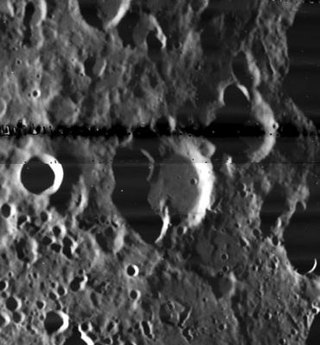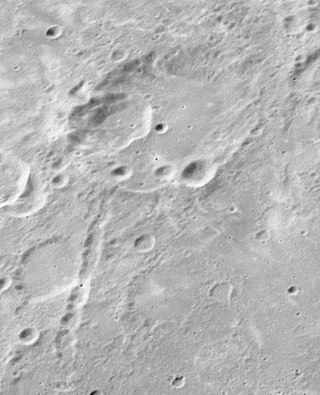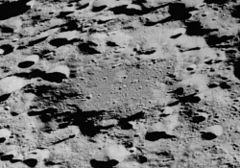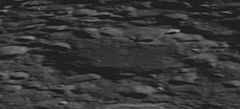
Anaximenes is a low-rimmed lunar impact crater near the north-northwest limb of the Moon. It lies to the west of the crater Philolaus, and northeast of Carpenter. To the northwest is Poncelet, close to the visible edge of the Moon.

Cantor is a lunar impact crater that is located on the northern hemisphere on the far side of the Moon. The outer rim of the crater has a distinctly hexagonal shape, and is slightly longer in the north–south direction. The interior walls are multiply terraced, although less so along the western rim. There is a low central peak at the midpoint of the floor.

Fizeau is a prominent lunar impact crater that is located on the far side of the Moon, in the southern hemisphere. Nearby craters of note include Minkowski to the west-northwest, and Eijkman to the southwest.

Büsching is a lunar impact crater that is located in the crater-covered southern highlands of the Moon. It was named after German geographer Anton F. Büsching. The similar-sized crater Buch is located adjacent to its southwestern rim, and further to the southwest lies Maurolycus.

Chamberlin is a lunar impact crater that is located on the far side of the Moon, just past the southeastern limb. It lies to the southeast of the crater Jeans, and Moulton is attached to the southeastern rim of Chamberlin. This crater is located in a part of the lunar surface that has undergone resurfacing of crater interiors, producing dark-hued crater floors.

Becquerel is a lunar impact crater that lies in the northern hemisphere on the far side of the Moon. This is an ancient and heavily worn formation that is now little more than an irregular buri in the surface. The outer rim has been worn and reshaped until it forms a rugged, mountainous region around the flatter interior.

Casatus is a lunar impact crater that is located near the southern limb of the Moon. The north-northeast rim of the crater overlies a portion of the slightly larger crater Klaproth. Along the western rim, Casatus A intrudes somewhat into the interior, producing an inward-bowing rim. To the southeast of Casatus is Newton.

Chappell is a lunar impact crater on the far side of the Moon, in the northern hemisphere just to the north of the crater Debye. It is in a heavily bombarded section of the surface, and much of its outer rim is overlain by smaller craters. The northern rim in particular has been almost completely disintegrated, while small craters also overlie the rim to the northwest and southeast. What remains of the rim forms a rounded, somewhat irregular edge to the crater depression.

Coriolis is a lunar impact crater that is located on the far side of the Moon. The crater floor is bisected by the lunar equator, and it lies about three crater diameters northwest of the crater Daedalus.

Dove is a small lunar impact crater located in the rugged lunar highlands in the southeastern part of the Moon. It lies to the north of the prominent crater Pitiscus. The crater is named after Prussian physicist Heinrich Wilhelm Dove.

Charlier is a lunar impact crater that is located on the far side of the Moon. To the south-southeast is the larger crater Kovalevskaya, and northeast of Charlier is Perrine.

Eimmart is a lunar impact crater that is located near the east-northeastern limb of the Moon, to the northeast of the Mare Crisium. The northern and eastern outer rim of this crater borders on the narrow Mare Anguis. To the northwest of Eimmart are the smaller crater Delmotte and the prominent Cleomedes.

Faye is a heavily eroded lunar impact crater in the rugged southern highlands of the Moon. It is named after French astronomer Hervé Faye. It is attached to the northeastern rim of the crater Delaunay, with Donati located just a few kilometers to the northeast. It forms part of a chain of craters of increasing size to the southwest that continues with La Caille and ends with the walled plain Purbach.

Douglass is a lunar impact crater on the far side of the Moon. It lies to the southwest of the crater Frost and south-southwest of the large walled plain Landau.

Dziewulski is a lunar impact crater on the far side of the Moon. It lies between the craters Edison to the north and Popov to the south. The outer rim of this crater has been considerably worn by impacts, particularly along the southwest quadrant where the satellite crater Dziewulski Q overlies the rim and the interior floor. The northern rim is also heavily disrupted, and several small crater lie along the southeast rim. The interior floor and surrounding terrain has been resurfaced.

Dante is a lunar impact crater that is located on the far side of the Moon. It lies in the northern hemisphere exactly opposite the prime meridian facing the Earth. The nearest craters of note are Larmor to the north and Morse to the southeast. To the southwest is the oddly shaped Buys-Ballot.

Fersman is a large lunar impact crater on the Moon's far side. It lies to the east of the crater Poynting, and west-northwest of Weyl. To the south is the huge walled plain Hertzsprung.

Fischer is a lunar impact crater that lies in the northeastern part of the interior floor of the huge walled plain Mendeleev. This feature is located on the far side of the Moon relative to the Earth, and can only be viewed from a spacecraft.
Foster is a small lunar impact crater that lies to the southeast of the larger crater Joule, on the far side of the Moon. The rim of Foster is slightly eroded, and the narrow inner walls slope directly down to the relatively dark interior floor. The rim has a small outward bulge along the southwest side. There is a small craterlet on the floor next to the northern rim. A tiny impact in the southeast part of the crater interior is surrounded by a small skirt of high albedo material, producing a bright patch.

Fowler is a large lunar impact crater that lies in the northern hemisphere on the Moon's far side. It lies to the south-southwest of the crater Esnault-Pelterie, and north of Gadomski. Overlying the eastern rim and intruding into the interior is Von Zeipel.





















